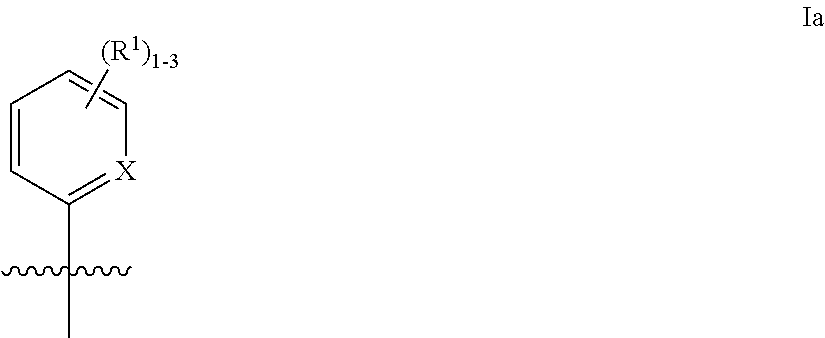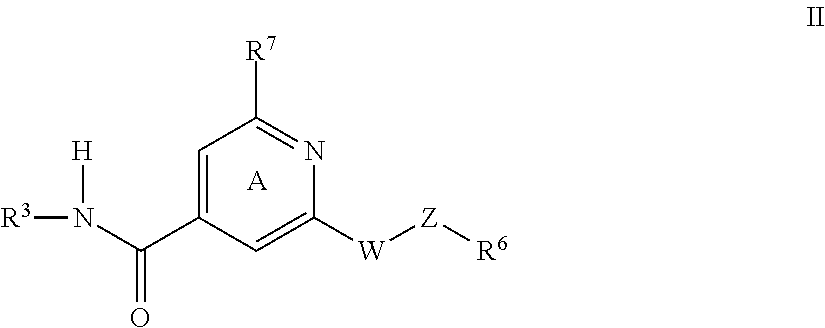P2x3, receptor antagonists for treatment of pain
a p2x3, receptor-based technology, applied in the field of compounds, can solve the problems of complex utility of purinergic ligands available to evaluate the role of individual p2 receptor subtypes in mammalian physiology, intense pain, and pronounced increase in sensory nerve discharg
- Summary
- Abstract
- Description
- Claims
- Application Information
AI Technical Summary
Benefits of technology
Problems solved by technology
Method used
Image
Examples
example 1.32
[0155]
2-(2-Fluoro-4-methylphenyl)-6-morpholin-4-yl-N-[(1S)-1-(4H-1,2,4-triazol-3-yl)ethyl]isonicotinamide
Step A: Methyl 2-chloro-6-(2-fluoro-4-methylphenyl)isonicotinate
[0156]To a solution of methyl 2,6-dichloroisonicotinate (3.34 g, 16.2 mmol) in toluene (100 mL) were added (2-fluoro-4-methylphenyl)boronic acid (1.4 g, 9.09 mmol), (tetrakistriphenylphosphine)palladium (0) (0.94 g, 0.81 mmol) and sodium carbonate (2.0 M in water; 8.1 g, 16.2 mmol). The mixture was degassed with nitrogen (3×) and heated to 80° C. After 42 h, the mixture was cooled to ambient temperature and saturated NaHCO3 was added. The mixture was extracted with ethyl acetate (3×). The combined organic extracts were washed with brine, dried over sodium sulfate, filtered and concentrated. Purification by reverse phase chromatography (C-18, 85% water / acetonitrile→5% water / acetonitrile with 0.1% trifluoroacetic acid) gave the title compound (1.07 g). MS 280.0 (M+1).
Step B: Methyl 2-(2-fluoro-4-methylphenyl)-6-morphol...
example 1.62
[0160]
2-(2,4-Difluorophenyl)-6-(1-hydroxy-1-methylethyl)-N-{(1R)-1-[1-oxido-6-(trifluoromethyl)pyridin-3-yl]ethyl}isonicotinamide
Step A: Methyl 2-(2,4-difluorophenyl)-6-isopropenylisonicotinate
[0161]To a degassed solution of methyl 2,6-dichloroisonicotinate (0.1 g, 0.49 mmol), tripotassium phosphate (0.16 g, 0.73 mmol), palladium(II) acetate (8.72 mg, 0.04 mmol) and tris(2-methoxyphenyl)phosphine (27.4 mg, 0.08 mmol) in THF (1 mL) and water (0.25 mL) was added 2-isopropenyl-4,4,5,5-tetramethyl-1,3,2-dioxaborolane (0.11 mL, 0.61 mmol)) The mixture was heated to 65° C. After 4 h, a solution of (2,4-difluorophenyl)boronic acid (0.12 g, 0.73 mmol) in THF (0.5 mL) was added. The mixture was continued to stir at 65° C. After 18 h, the mixture was cooled to ambient temperature. Saturated aqueous NaHCO3 was added the mixture was extracted with ethyl acetate (3×). The combined organic extracts were washed with brine, dried over magnesium sulfate, filtered and concentrated. Purification by si...
example 1.63
[0164]
2-(2-Hydroxypropan-2-yl)-6-(4-methylphenyl)-N-[(1S)-1-(4H-1,2,4-triazol-3-yl)ethyl]pyridine-4-carboxamide
Step A: Methyl 2-(4-methylphenyl)-6-(prop-1-en-2-yl)pyridine-4-carboxylate
[0165]To a degassed solution of palladium(II) acetate (21.8 mg, 0.10 mmol) and tris(2-methoxyphenyl)phosphine (68.4 mg, 0.19 mmol) in THF (1 mL) was added a degassed mixture of methyl 2,6-dichloroisonicotinate (250 mg, 1.21 mmol), tripotassium phosphate (386 mg, 1.82 mmol), and 2-isopropenyl-4,4,5,5-tetramethyl-1,3,2-dioxaborolane (0.285 mL, 1.52 mmol) in THF (1.5 mL) and water (0.625 mL). The mixture was heated to 63° C. After 4 h, a degassed solution of 4-methylphenylboronic acid (247 mg, 1.82 mmol) in THF (1.25 mL) was added. The resulting mixture was heated to 63° C. After 18 h, 4-methylphenylboronic acid (247 mg, 1.82 mmol), palladium(II) acetate (21.8 mg, 0.10 mmol), and tris(2-methoxyphenyl)phosphine (68.4 mg, 0.19 mmol) were added. The resulting mixture was heated to 63° C. After 18 h, the mix...
PUM
 Login to View More
Login to View More Abstract
Description
Claims
Application Information
 Login to View More
Login to View More - R&D
- Intellectual Property
- Life Sciences
- Materials
- Tech Scout
- Unparalleled Data Quality
- Higher Quality Content
- 60% Fewer Hallucinations
Browse by: Latest US Patents, China's latest patents, Technical Efficacy Thesaurus, Application Domain, Technology Topic, Popular Technical Reports.
© 2025 PatSnap. All rights reserved.Legal|Privacy policy|Modern Slavery Act Transparency Statement|Sitemap|About US| Contact US: help@patsnap.com



